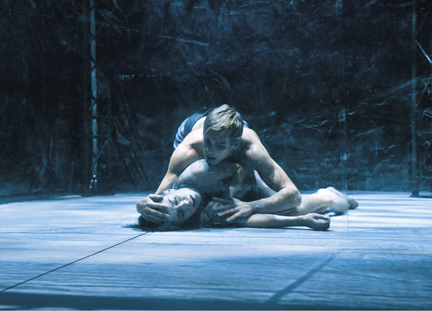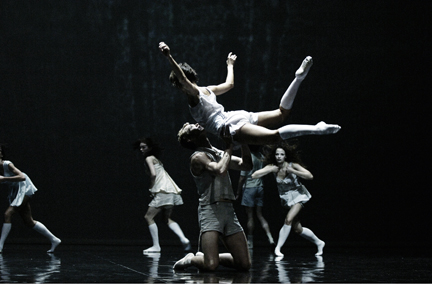Earth, Air, Wind and Fire
The Royal Danish Ballet
Coopenhagen, Denmark
Washington, DC
October 13 - 18, 2005
by Eva Kistrup
copyright ©2005 by Eva Kistrup
 Since the opening of the new Opera House at Holmen, The Royal Danish Ballet has five stages at its disposal: The Old Stage, The renovated New Stage, The Opera stage, Takkelloftet (the small stage at the Opera) and Tivoli’s Concert Hall (for the annual “Nutcracker” run). Unfortunately, production budgets and resources have not followed suit, leaving the company on the dangerous road of stretching resources in an attempt to fill out opportunities and put bums in seats, the latter being the main success criteria at The Royal Theatre and the primary reason why Bournonville is so scarce in this years’ repertoire. Bournonville does not sell well at home.
Since the opening of the new Opera House at Holmen, The Royal Danish Ballet has five stages at its disposal: The Old Stage, The renovated New Stage, The Opera stage, Takkelloftet (the small stage at the Opera) and Tivoli’s Concert Hall (for the annual “Nutcracker” run). Unfortunately, production budgets and resources have not followed suit, leaving the company on the dangerous road of stretching resources in an attempt to fill out opportunities and put bums in seats, the latter being the main success criteria at The Royal Theatre and the primary reason why Bournonville is so scarce in this years’ repertoire. Bournonville does not sell well at home.
One attempt to stretch the limited resources has resulted in the commissioning of new ballets by lesser known choreographers, a strategy that is cheaper than acquiring big names or international standard repertoire. By joining forces with the other Nordic ballet companies in a project NOKO (Nordic Choreographers) and by stipulating a sort of Dogme rules (inspired by the Danish film project founded by Lars von Trier, Breaking the Waves), one can appear progressive, international and modern on the outside, while being economical and gaining quantity on the inside. The risk with this venture is the quality of the works. There is no Nordic dance scene as such, and no artistic brothership in ballet (as there has been in art and literature). By applying Dogme rules and setting a theme (the four elements: earth, air, wind and fire) for the choreographers, you do not end up with the coherence wanted, but with four disparate pieces where only one really respected the commission. The other three choreographers just did what they wanted.
The strange  thing is that by fulfilling the commission and making a ballet on the theme “Earth” (Jord) the Finnish choreographer Jorma Uotinen created one of the best ballets created for the RDB in a decade and a ballet the company should treasure and tour. Uotinen, a former ballet master of the Finnish national ballet, is the most experienced of the four choreographers and “Earth” really shows his craftsmanship. The stage is filled with an earth-like material and 12 men, led by Thomas Lund, Kenneth Greve, Nicolaj Hansen and Tim Matiakis dressed in rough skirts over shorts, dance a variation of tribal dances, symbolising the relation between man and earth to astounding effect to music by the Finnish ensemble Apocalytica and Metalica and lighting by Mikki Kuntto. In one of the segments where the lighting simulates a thunderstorm, you actually disbelieve your own eyes. The lighting seems to control the dancers’ movements and you cannot decide whether you see real people moving or trickery. The energy is high and the effects stunning. “Earth,” which was the last piece on the program, was worth the whole evening.
thing is that by fulfilling the commission and making a ballet on the theme “Earth” (Jord) the Finnish choreographer Jorma Uotinen created one of the best ballets created for the RDB in a decade and a ballet the company should treasure and tour. Uotinen, a former ballet master of the Finnish national ballet, is the most experienced of the four choreographers and “Earth” really shows his craftsmanship. The stage is filled with an earth-like material and 12 men, led by Thomas Lund, Kenneth Greve, Nicolaj Hansen and Tim Matiakis dressed in rough skirts over shorts, dance a variation of tribal dances, symbolising the relation between man and earth to astounding effect to music by the Finnish ensemble Apocalytica and Metalica and lighting by Mikki Kuntto. In one of the segments where the lighting simulates a thunderstorm, you actually disbelieve your own eyes. The lighting seems to control the dancers’ movements and you cannot decide whether you see real people moving or trickery. The energy is high and the effects stunning. “Earth,” which was the last piece on the program, was worth the whole evening.
And a long evening it seemed, because, frankly, one of the three other works was merely average and two were extremely bad. First out was Louise Midjord, a member of RDB who has had some success with smaller snippets at various workshop performances. Her forte is Bridget Jones-type miniatures about relationships, but this time out she was trying for art, and it did not fit.  Her piece, “Water,” has every cliché used in modern dancing, like a couple captured in a big aquarium, faceless doll-like women, men in skirts, and a male protagonist whom we are to believe is reflecting on his life. The work is messy, unapproachable, and banal and has but little originality in its steps. I would much rather have seen Midjord staying in her comfort zone and developing her miniatures into a coherent work. This work simply sums up all the clichés we have witnessed in the last 30 years from dancers trying to become choreographers, fixating on trying to bring meaning to the piece. The only value these works can bring is that dancers get ample training in trying to look overpowered by the harsh and grinning social machine.
Her piece, “Water,” has every cliché used in modern dancing, like a couple captured in a big aquarium, faceless doll-like women, men in skirts, and a male protagonist whom we are to believe is reflecting on his life. The work is messy, unapproachable, and banal and has but little originality in its steps. I would much rather have seen Midjord staying in her comfort zone and developing her miniatures into a coherent work. This work simply sums up all the clichés we have witnessed in the last 30 years from dancers trying to become choreographers, fixating on trying to bring meaning to the piece. The only value these works can bring is that dancers get ample training in trying to look overpowered by the harsh and grinning social machine.
As for Helen Franzéns’ “Fire,” even less happened. Four dancers simply accompanied the music of Silverbullit, a good Swedish heavy metal group, with their movements. Soloist Fernando Mora wore make up that would have done well at an entrance exam to KISS, Cedric Lambrette had dyed red hair, and the two girls—Mie Fjeldstrup and Esther Lee Wilkinson—looked like groupies, but the dancing showed no analysis or interpretation of the Heavy Metal scene, nor did the dancing command the stage. Whatever ballet is supposed to be, surely it must be more than fan worshipping.
When I was a young literature student I read a lot of books by the Norwegian Nobel Prize-winning author Sigrid Undset, but finally I grew tired, because all protagonists eventually got TB. Her fellow Norwegian, Jo Strømgren, contributed a work, “Air,” that bought me back to the feeling of the Undset universe. Four couples dressed in old fashioned lingerie struggled for air in a poetic allegory about lung cancer. The music was a mixture of Beethoven and F16 airplanes. It was not as crazy as it sounds. Strømgren can make a group move and his steps are original. Amy Watson and Gitte Lindstrøm managed to get the work across.
Almost simultaneously RDB had a short run at Takkelloftet with a programme consisting of works by Nils Christie, Twyla Tharp and Petr Zuska, but this run lasted less than a week, and I was not able to attend a performance. I understand however that Christie’s ballet took its theme from Danish Design classic No 7, a chair by Arne Jacobsen.
 In all, such programs confirm my view that modern ballet in the larger classical ballet institutions is in a crisis, not regarding the style but regarding the contents. The need to produce new programmes and the number of would-be choreographers seems so much bigger than the actual need to convey anything. Choreography can only exist if the choreographer can produce something of relevance, but as this evening showed, a good craftsman can convey a lot of meaning even with a set subject and by the wish of giving something back to the audience.
In all, such programs confirm my view that modern ballet in the larger classical ballet institutions is in a crisis, not regarding the style but regarding the contents. The need to produce new programmes and the number of would-be choreographers seems so much bigger than the actual need to convey anything. Choreography can only exist if the choreographer can produce something of relevance, but as this evening showed, a good craftsman can convey a lot of meaning even with a set subject and by the wish of giving something back to the audience.
Two of the new ballets—Midjord’s “Water” and Strømgren’s “Air”—will be transmitted by Danish Television in a gala next month when the Norwegian King makes a state visit. I am sorry that it was not the Finnish president we will receive. That way we could have seen a really good ballet. But when nationality takes precedence over quality, the mediocre may benefit.
Photos: (all by Henrik Stenberg)
First: Fernando Mora and David Kupinski in Helena Franzen's "Ild".
Second: Thomas Lund and Tim Matiakis in Jorma Outinen's "Jord."
Third: Cecilie Lassen and Coonstantine Baecher in Louise Midjord's "Vand."
Fourth: Gitte Lindstrøm and Andrew Bowman in Jo Gitte Strømgren's "Luft."
Volume 3, No. 39
October 24, 2005
copyright
©2005 Eva Kistrup
www.danceviewtimes.com
|
|